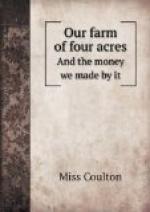In some parts of the country, the butter made by the farmers’ wives for sale is not washed at all; they say, “It washes all the taste away.” They remove it from the churn, and then taking it in their hands, dash it repeatedly on the board; that is what they call “smiting” it. The butter so made is always strong, and of two colors, as a portion of the buttermilk remains in it: if any of it were put into a cup, and that placed in hot water, for the purpose clarifying, there would, when it was melted, be found a large deposit of buttermilk at the bottom of the cup. We have tried the butter made our way, and there was scarcely any residuum.
Besides, this “smiting” is a most disgusting process to witness. In warm weather the butter adheres to the hands of the “smiter,” who puffs and blows over it as if it were very hard work. Indeed, I once heard a strong-looking girl; daughter of a small farmer in Kent, say she was never well, for “smiting” the butter was such dreadful hard work it gave her a pain in her side. After this “smiting” is over, it is put on a butter-print, and pressed with the hands till it is considered to have received the impression. It is then, through a small hole in the handle, blown off the print with the mouth.
I don’t think I shall ever again eat butter which appears at table with the figures of cows, flowers, &c., stamped on it. I should always think of the process it has gone through for the sake of looking pretty. Nearly all the fresh butter which is sold in London is made up in large rolls, and, like that we make ourselves, need not be touched by the fingers of the maker.
CHAPTER V.
WHAT WE MADE BY OUR COWS.
Every week we kept an account of the milk and butter we consumed, and entered it in our housekeeping-book at the price we should have paid for it, supposing we had purchased the articles. We did not put down London prices, but country ones: thus, we charged ourselves with milk at 6 cents the quart, and butter 27 cents the pound; at the end of six months we made up our accounts, and found we should have paid for milk from the 14th to the 24th of January, $44, and $66 for butter. The food for the cows during this period cost us but $4 50, which we paid for oil-cake, of which, when the weather became cold, they had two pounds each daily. We do not reckon the value of the hay they consumed during winter, because we included the land in our rent. We mowed three




